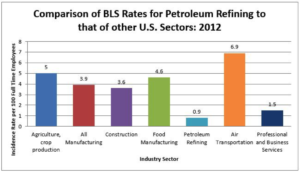A recent L.A. Times article on May 10th by Kathleen Luppi was a celebration of 100,000 accident free work hours at Christ Cathedral.
Another California company has done even better. The Phillips66 Refinery in Wilmington just had a BBQ celebrating more than 2,400,000 man-hours with no OSHA recordables over a 3 year period.
Coincidentally, the American Society of Civil Engineers (ASCE) is preparing to issue in 2019 their infrastructure report card for 17 infrastructures that did not exist prior to the 1900’s and they could not exist without the chemicals and by-products manufactured from crude oil.
The ASCE will be highlighting in the Energy Infrastructure that for the downstream refining sector of the energy infrastructure, the Bureau of Labor Statistics (BLS) shows that the industry has been reducing the risk of all injuries – including serious injuries and fatalities – for the last 20 years. The downward trend is indicative of an industry that has a strong management commitment to safety and health and strives for a culture of continuous improvement.
The BLS charts the petroleum refining sector of health and safety data as one of the safest industries to work in.

Phillips66’s achievement is consistent with the BLS statistics, that the downstream refining sector is one of the safest places to work. In addition, the refining sector also offers high paying jobs to 1,000’s of workers and contributes significantly to the state’s economy.
Safety is the highest priority for the refining and petrochemical industry, and the industry’s safety record is concrete evidence of its commitment to continuously improving its performance. Although the industry is already a leader in process and occupational safety, it continues to take voluntary actions to improve and raise the bar for all industry players, while serving as an example for other manufacturing sectors.
California is unique in that we are an “energy island” to its almost 40 million citizens, bordered between the Pacific Ocean and the Sierra Nevada Mountains. California has 35 million registered vehicles of which 93% are not electric vehicles (EV’s).
With California being one of the most environmentally regulated locations in the world, continuing the manufacturing in-state, of aviation fuel, gasoline, diesel, and marine fuels is needed to maintain the lowest levels of emissions.
For California’s 35 million registered motor vehicles, of which more than 90% are not EV’s, DAILY fuel needs in 2016 were 42 million gallons of gasoline, and 10 million gallons of diesel. Sounds like a lot of fuel, but it’s only a little more than one gal/day/vehicle, resulting in refueling every week or two. Daily demand at California’s 145 airports, inclusive of 33 military, 10 major, and more than 100 general aviation airports, consumes 10 million gal/day of aviation fuels. In addition, California requires vessels calling on its ports to use special marine fuel.
With all the pressures on industries to be profitable, it exciting to learn of the focus that firms are placing on the safety and the well-being of their workforce.

